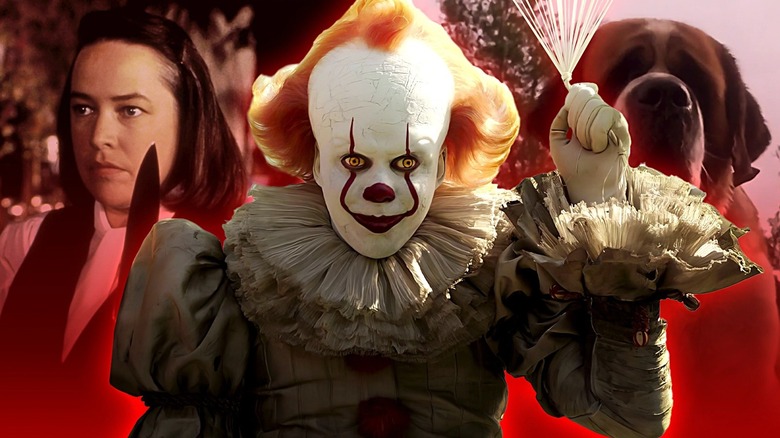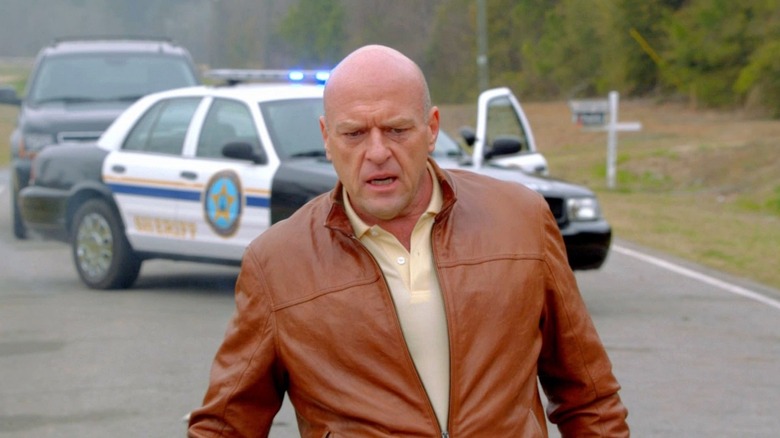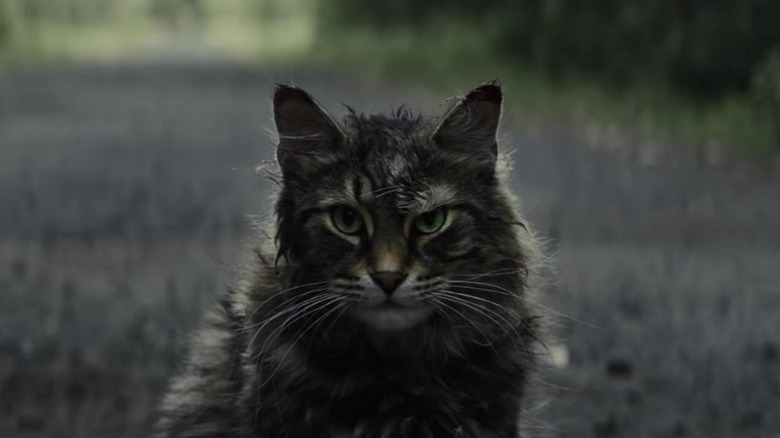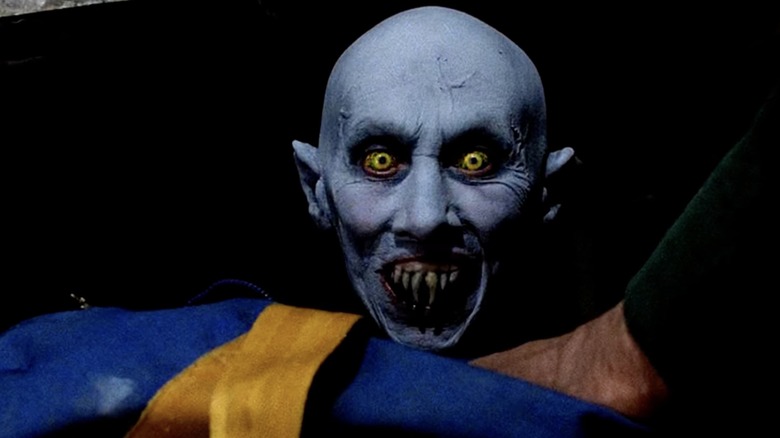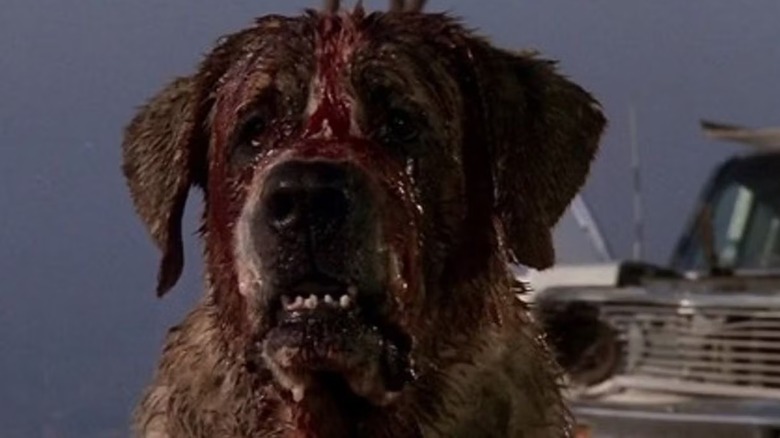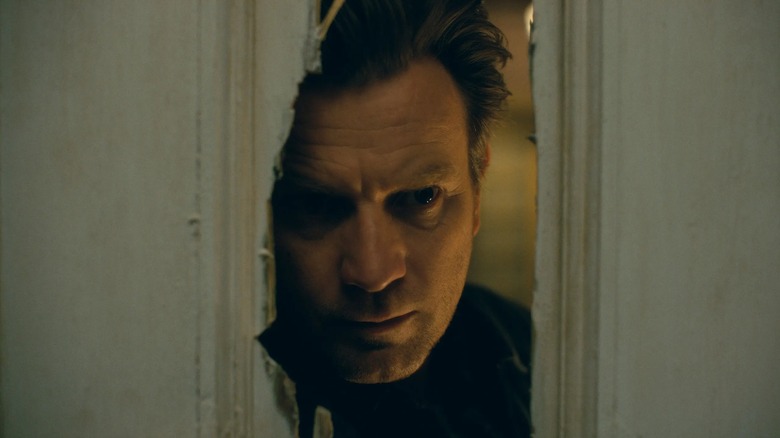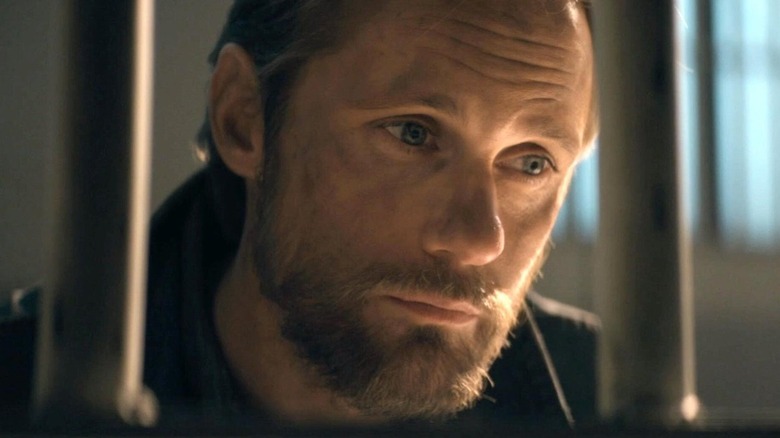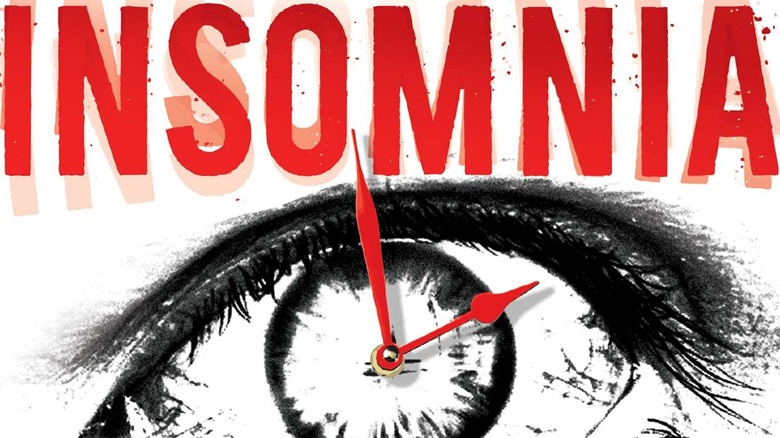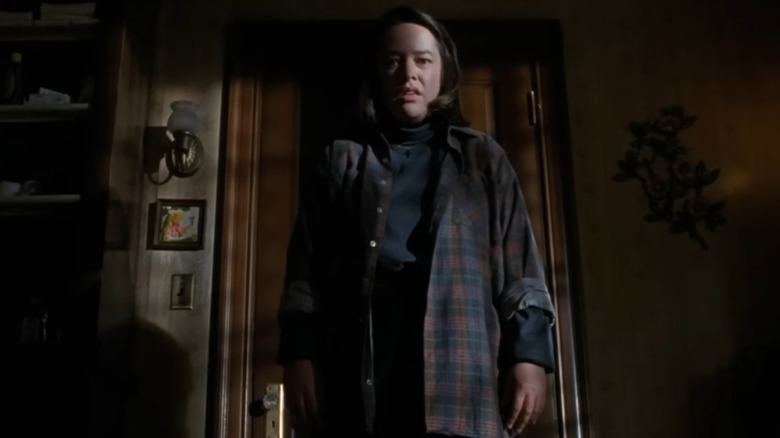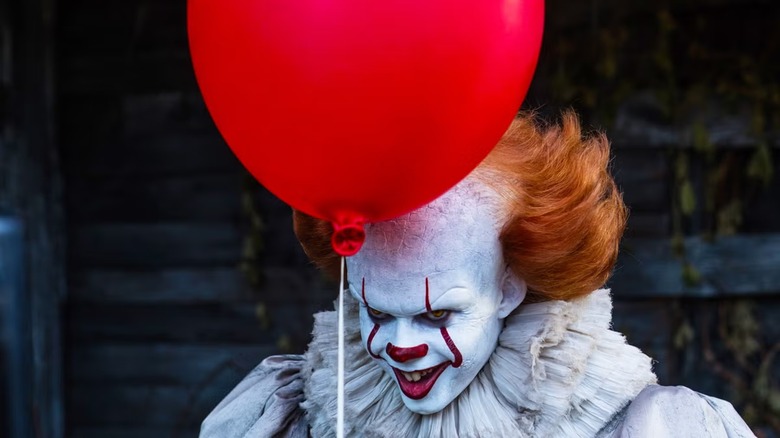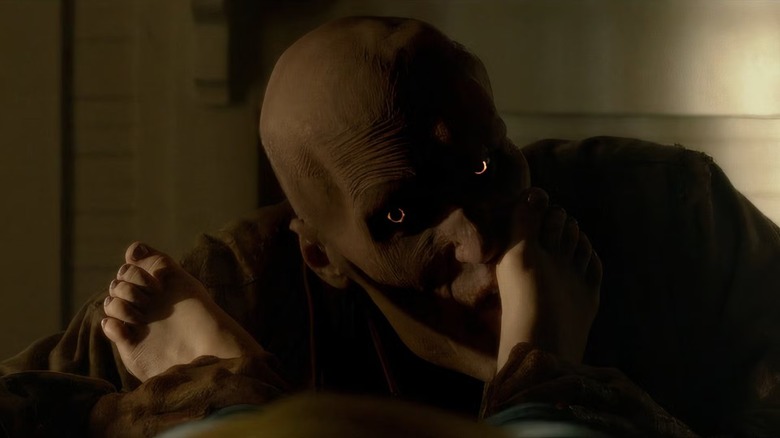Stephen King's 10 Scariest Books, Ranked
Since the publication of "Carrie" in 1974, Stephen King's been a consistent hot topic in horror circles. This slim saga of a girl tormented past the point of ever using her telekinetic powers for good landed like a bang, and from the start savvy readers could spot the influences King grew up with. Stories of dangerous mental abilities, vampires, and self-devouring societies quickly point to a childhood of wonderful pulp sci fi and horror, from cheapie Vincent Price classics to the works of "Twilight Zone" veteran writer, Richard Matheson.
It's an all consuming love for both the joy and goopy scares of the horror genre, but more visceral horror sometimes colors his work, too. The vague memories of a four year old King shape "The Body," as one of his friends was killed by a train, and it's not just his magnum opus, "The Dark Tower" that relived King's personal experience of being hit and nearly slain by a truck. A new, dreadful sense of mortality permeates his books since, and that's more unbearable than vampires or vengeful spirits. Yet it's all great, fun stuff, and today we're presenting our choices for his ten biggest, spookiest scares. Come along, Constant Reader, and let's revisit why King is, well, still our king of horror today.
Under the Dome
"Under the Dome" is "The Monsters Are Due On Maple Street" writ large. That's one of the best "Twilight Zone" stories ever made, and its themes have been revisited by more creators than King alone: When strange events throw the little micro-society of Maple Street into chaos, their own paranoias tear each other apart. In "Under the Dome" the scale is upped to include an entire town, with complex social ties meaning it takes longer for them to visit an apocalypse onto themselves.
When published in 2009, "Under the Dome" took valid critical knocks for being pretty on the nose as a diatribe about selfish societies and their ecological impacts. It's certainly not subtle, and the reveal of what's actually behind the dome is some silly, old-school sci fi stuff. And yet, like King's portrayal of a Trump-like villain at the heart of "The Dead Zone," the broad swaths of this trapped society perfectly happy to empower themselves at the cost of what will eventually be pretty much everyone else hits different as we enter a dangerous second administration full of sycophants and power leeches. "Under the Dome" earns a fresh layer of grim under our current reality. It may be obvious stuff, but King was still right to say it. Unfortunately, the television adaptation of this saga doesn't hit all the right notes, and King himself will be the first to tell you about it.
Pet Sematary
Two things are pretty much guaranteed to bring anyone to their knees: the loss of a child, and the loss of a pet. Before anyone starts, we're not saying these tragedies are equal on all levels. But in both cases, we're losing someone that depends on us as much as we love and care for them. Both are emotional bonds that can cause terrible grief, and to write an entire novel about that grief is already a warning that this is going to be some tough stuff to read.
"Pet Sematary" is incredibly tough, going all the way towards a child's grave to describe what the shattered father sees there. It's a scene that only made it into the original film adaptation, and then, only barely. That's how heart-wrenching King is willing to be. That's more than horror enough for our taste, but the only thing worse is the escalating way the dead return, full of a malicious need to return terror onto a world that said goodbye to them. It is worth noting that this bleak power at first seems entwined with the burial grounds of a local Indigenous tribe (yikes), but to King's credit, there's a swerve to that story that, while still a little clunky, lines up much better with the folklore of the Mi'kmaq and many other Indigenous communities.
Salem's Lot
Hot vampire winter doesn't have to end with Robert Eggers' "Nosferatu"! Though "Salem's Lot" has undergone a line of adaptations that seem to get worse and worse with each iteration, the original novel still has plenty of classic, almost Matheson-style moments of gaslighting horror. It's not just that a vampire and his familiar is slowly eating their way through the town, it's how the book's protagonists are fighting uphill against our modern beliefs of "of course that can't happen here!" "Nosferatu" star Aaron-Taylor Johnson's stoic Harding would've fit right in, including, probably, the same unnerving ending he found in his family's tomb.
Worse than the disbelief is a late game fumble by the town's priest against the lead vampire. "The Exorcist" had already prepped audiences by showing the Devil only barely losing to a psychiatrist priest who had no idea this was going to go this far. "Salem's Lot" pits poor Father Callahan in a fight for his faith, and the result is not going to go in the local church bulletin. But that's okay, because by the end, there won't be any of those anymore in the Lot, either.
A vampire novel happy to go bleak, it's a nice antidote to shiny vampires working hard to seem hot, when what we really want is these bastards to scare us into admiring them. Meanwhile, Callahan will get a second chance at redeeming his faith late in "The Dark Tower" saga.
Cujo
Without speaking for all readers, a non-zero number of them might have learned about rabies for the first time from "Cujo." Take it from us, it's one hell of a trial by fire, as the viewpoint chapters from the dying St. Bernard's angle are tragic, horrifying, and a little too real. Like "Pet Sematary," Cujo also manages to hit the tragedy behind the loss of a child. This time, however, there's no coming back. The supernatural, in "Cujo," is mostly a savory afterthought, a musing on the concept of a "haunting" as both ghostly and a gathering place for predators. It's also a nice tie to "The Dead Zone," but that's all it really is.
Yet as god awful as it is to read as two people wither to death in a hot car with little chance of outside help, it's the rabies that pushes this once good dog above an undead hellcat, simply for that malignant realism. The abject horror of your body betraying you, depriving you of water, and shelling you out from the inside isn't even as rare as we'd hope; this nightmare disease killed an American woman in November of last year, and tens of thousands worldwide annually. Please, do not play with bats unless you're a specialist aware of the risks, and if you see a raccoon — or any mammal — acting strangely, don't mess with it. Call the experts. Do it for Cujo, who only ever wanted to be a good boy.
Doctor Sleep
"The Shining" doesn't quite make this list of big league horrors, though it is a personal favorite in general. Its slow-burning domestic hell is slightly softened by the uniqueness of this overall scenario — not only are you trapped alone with your abusive spouse, but this distant locale is also mega haunted. Yet that's subjective, and it still sets up the mortal terrors of its descendant, "Doctor Sleep."
The adult Danny carries enough post-childhood trauma to ensure we feel for him, even as he lives a drifting life frightened of becoming his father. But his empathy also draws him to those he can help, and his new life in hospice, treating people at the ends of their lives, is both bittersweet and sometimes haunting to those of us frightened of our mortality. Matched with that is one of King's best villains to date, the voracious Rose the Hat. Described as a psychic vampire, our opinion is that her behavior is better categorized as a spiritual cannibal. There's no mercy, no humanization of her prey, and a complete disregard of whether she ever had any life as a human, herself. Colin Robinson would be less than thrilled about hanging out with this crew.
The Stand
"The Stand" is a grandiose epic about how a relatively straightforward battle between good and evil begins with a few sneezes. Like "Under the Dome," there's not a lot of subtlety to explore about how the selfish and submissive wind up under a dark master out of Sin City, Las Vegas after the plague annihilates much of the world. It's nice that being a little flawed doesn't mean you're kicked out of Colorado, where it's not so much about being pure Christian faithful as it is about fighting to help each other thrive in hard times. Yes, King's fondness for the magical Black person is still a little out of place and out of pocket, but a lot of readers are happy to call "The Stand" their favorite Stephen King novel of all time. That's a fair call, in our opinion. It's a dark fantasy set in our world, but it's also more than that now.
It's the first half, where the flu-like superbug ravages America, that sticks in the memory the most. Scenes of the second wave of deaths and the dwindling humanity that sees juntas happily engage in maddened slaughter live on TV are prime horrific stuff. But like "The Dead Zone," "The Stand" has also amplified its flavor with time. COVID-19 isn't actually in the back mirror and the bird flu continues to make headlines. The last thing Las Vegas needs is a telekinetic maniac sorcerer popping up.
Insomnia
At some point in their lives, most people will go through a bout of insomnia. It may not be too bad as the sleep disorder goes; a college student's four days during exam season, an ER doc in a hell season. A family tragedy. Insomnia sucks, but the harshest forms of it can be traumatizing, leading to hallucinations, physical degradation, and even, in the case of a rare prion disease called FFI, it can lead to death. Bad enough in reality, but what if those sleepless hallucinations let you see through reality into pockets of what you shouldn't? What if you learn exactly how fragile our mortal threads are?
"Insomnia" goes all the way into an almost Lovecraftian vision of nightmarish restlessness, playing up on the exhaustion and agony all those hours we've never slept through can cause. Ralph, our writer protagonist, ends up having the raw horror of his insomnia slightly softened by the way it entwines heavily with "The Dark Tower," giving everything an extra cast of dark fantasy. It doesn't change how much insomnia sucks, and how probable it is in our own lives. Forget the Benadryl hat man, there's worse things possible outside the land of dreams.
Misery
A recent post on Tumblr asked the question of whether or not Annie Wilkes, the obsessed, deadly fan at the heart of "Misery," would have a blog on the site if she really existed. Of course she would, and that's not to denigrate the site. If anything, maybe having had a community to share her fanfiction ideas about Misery Chastain would have prevented her from abducting and nearly killing author Paul Sheldon.
What makes "Misery" so utterly terrifying is that the idea of Annie Wilkes is tragically very real. Her name is Mark David Chapman, the fan who realized he would never share a life with his idol, John Lennon, the way he wanted, so he 'took' Lennon for himself with a gun. Her name is John Hinckley Jr., the man who shot Reagan to woo Jodie Foster.
In 1991, after the release of "Misery" in theaters, Stephen King's home was invaded by a man claiming he had a bomb. The question is not whether Annie Wilkes would engage in online fandom today. It's "how many of her are there?" Worse, in real life, stalking is an all too common threat, and you don't have to be famous to be at risk.
It
Pick what scares you more about "It," the sprawling horror epic that defines the fictional small town of Derry, Maine: Generations of horrific death seasons that reach back centuries, and which is currently best fed by the luring and torture of children, already a hot topic fear when "IT" was published in 1986. Or a being of pure cosmic evil that can not only take the shape of everything that scares you the most but also defaults to a nigh-incomprehensible concept of some massive, all encompassing arachnid? One preys on the likelier horrors surrounding the violent loss of a child. The other may not be as likely, but it would probably kill a lot of us on sight.
There's nothing flippant about the nightmares found in "It," and while its most controversial scene has some thematic explanation — it's tangling together ideas of innocence and childhood, adulthood and wisdom, etc. — the execution, which involves heavily underage group sex, is bad. Yet that mistake doesn't drag the rest of the book down, not when its historical flashbacks lurk in our minds decades after reading. Not when we're still so scared of clowns. And not when Pennywise actor Bill Skarsgård can actually do that thing with his eyes, yeeeeegh.
Gerald's Game
Consent is important in ensuring relationships thrive, and it's not just a matter of sexual consent. Being able to trust our partners in a wide range of big issues is crucial to making the hard work of partnership last. Poor Jessie Burlingame, the heroine of "Gerald's Game," only marginally consented to her husband's idea of a kinky weekend at a secluded cabin. He ignores her when she withdraws consent to the escalating BDSM scene he's concocted, heading straight to marital rape. Fun reminder, American states only began to regard marital rape as a crime in the 1970s, becoming a nationwide statue in 1993. There are still states today, however, where the crime is handled with less severity.
"Gerald's Game" was written in 1992, so we already see this isn't great news for Jessie. On the bright side, her husband quickly suffers a heart attack when she resists! We love karma. On the dark side, she was already handcuffed to the bed, cellphones haven't gone into wide use, and there's a creepy shadow man haunting her as the hallucinations set in. Then it gets worse. For women, "Gerald's Game" is one of the scariest novels of all time, period. For guys, look. This is one of King's more probable scenarios, and we'd love it if you saw it through our eyes. As a terrific "Saturday Night Live" sketch once said, welcome to Hell.
If you or anyone you know has been a victim of sexual assault, help is available. Visit the Rape, Abuse & Incest National Network website or contact RAINN's National Helpline at 1-800-656-HOPE (4673).
